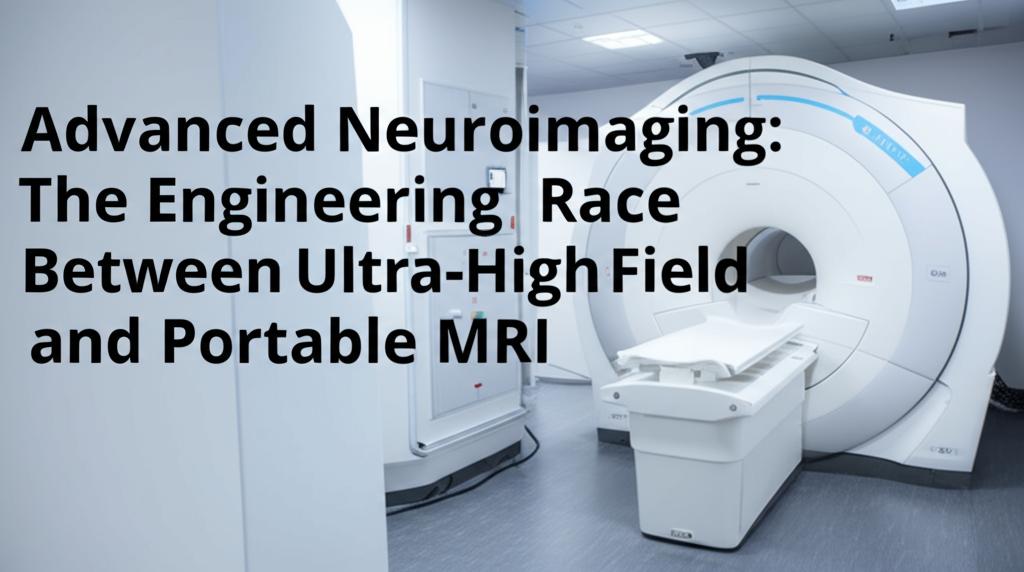Magnetic resonance imaging (MRI) technology is advancing rapidly on two seemingly divergent paths. On one end, engineers are pushing the limits of magnetic field strength to achieve unprecedented image detail with Ultra-High Field (UHF) MRI. On the other, a parallel effort focuses on making MRI technology smaller, more affordable, and accessible through the development of portable, lower-field systems. This divergence represents a fascinating engineering race, driven by different clinical needs and technological challenges.
The Quest for Ultimate Detail: Ultra-High Field (UHF) MRIUHF MRI typically refers to systems operating at magnetic field strengths of 7 Tesla (7T) and above, significantly higher than the standard clinical 1.5T and 3T scanners. The primary driving force behind UHF is the potential for significantly higher signal-to-noise ratio (SNR) and contrast-to-noise ratio (CNR).
- Engineering Marvels: Creating stable, homogeneous magnetic fields at 7T and beyond requires immense engineering sophistication. This involves powerful superconducting magnets needing complex cryogenic cooling systems, advanced gradient coils for spatial encoding, and specialized radiofrequency (RF) coils designed to work efficiently at higher frequencies.
- Advantages: The high SNR translates directly into the ability to acquire images with sub-millimeter spatial resolution. This allows visualization of extremely fine anatomical structures, such as cortical layers in the brain, subfields of the hippocampus, or tiny blood vessels less than a millimeter in diameter. This level of detail is invaluable for research into neurodegenerative diseases like Alzheimer's and Parkinson's, understanding complex neural circuits, precisely detecting small lesions in conditions like epilepsy or multiple sclerosis, and improving the characterization of tumors. UHF also enhances sensitivity for functional MRI (fMRI) and MR Spectroscopy (MRS), providing richer information about brain activity and metabolism.
- Challenges: UHF systems face significant hurdles. The shorter RF wavelengths at high fields lead to B1 field inhomogeneity, causing uneven image contrast and signal dropouts. B0 field inhomogeneities also become more pronounced. Technical solutions like parallel transmission (using multiple independent RF transmit channels), advanced B1 and B0 shimming techniques, and sophisticated coil designs are constantly being developed to mitigate these effects. Furthermore, Specific Absorption Rate (SAR), or the rate at which RF energy is absorbed by the body, increases with field strength, requiring careful management to ensure patient safety. Motion artifacts can also be more pronounced in high-resolution images. Lastly, the sheer cost, size, weight, and complex infrastructure requirements (specialized rooms, shielding, cooling) limit the widespread clinical adoption of UHF MRI, keeping it primarily in research and specialized clinical centers.
Contrasting with the "bigger is better" approach of UHF, portable MRI focuses on accessibility, point-of-care diagnostics, and deployment in resource-limited settings. These systems typically operate at low-field strengths (often below 0.1T, with examples like 0.064T or 0.55T) and employ different magnet technologies.
- Engineering Innovations: The key engineering challenge for portable MRI is achieving clinically useful image quality despite the inherently low SNR of low-field systems. Innovations include:
Magnet Design: Using permanent magnets (like Neodymium or Samarium-Cobalt arrays, sometimes in Halbach configurations) eliminates the need for cryogenic cooling and massive power supplies, drastically reducing size, weight, and cost. Engineers work to optimize magnet designs for field homogeneity within a compact footprint. Some designs minimize stray magnetic fields, reducing shielding requirements.
Hardware Optimization: Highly optimized and efficient gradient and RF coil systems are crucial.
* Advanced Software & AI: Sophisticated image reconstruction algorithms, compressed sensing techniques, and Artificial Intelligence (AI)-driven noise reduction and image enhancement play a vital role in boosting image quality from low-field data. AI is also being integrated to assist with image acquisition and interpretation.
- Advantages: The most significant advantage is accessibility. Portable MRI units can be wheeled to a patient's bedside in the ICU, used in emergency departments, operating rooms, mobile stroke units, remote clinics, or developing countries where conventional MRI is unavailable due to cost and infrastructure barriers. Systems like the Hyperfine Swoop operate off standard wall outlets. This point-of-care capability allows for faster diagnosis and monitoring for conditions like stroke, hydrocephalus, or traumatic brain injury, especially in critically ill patients who cannot be easily transported. The lower magnetic fields also present fewer safety concerns regarding metallic implants compared to high-field systems. The reduced cost makes MRI feasible for a much broader range of healthcare settings globally.
- Challenges: The fundamental limitation is the lower SNR and spatial resolution compared to high-field MRI. While adequate for detecting larger pathologies like hemorrhage or significant infarcts, smaller lesions might be missed. Scan times may need to be longer to acquire sufficient signal, although AI acceleration techniques are mitigating this. Low-field systems can also be more susceptible to electromagnetic interference. Furthermore, widespread adoption requires training personnel to operate these new systems and interpret potentially different-looking images effectively. Maintenance and service logistics, especially in low-resource settings, also need consideration.
The "race" between UHF and portable MRI is less about direct competition and more about pushing engineering boundaries towards opposite ends of the imaging spectrum to meet diverse needs. UHF MRI aims for the ultimate level of detail, driving neuroscience research and specialized diagnostics forward. Portable MRI aims for maximum accessibility and point-of-care utility, democratizing neuroimaging and bringing its benefits to previously unreached patient populations and settings.
Both fields are rapidly evolving. UHF technology benefits from ongoing improvements in coil design, field correction techniques, and sequence optimization. Portable MRI leverages breakthroughs in magnet technology, electronics, and especially AI-driven image processing to continually improve image quality and diagnostic utility. Systems exploring intermediate field strengths (like 0.55T) are also emerging, attempting to balance image quality with accessibility benefits like reduced siting requirements and improved implant compatibility.
Ultimately, both ultra-high field and portable MRI development contribute significantly to the advancement of neuroimaging, offering complementary tools that expand our ability to understand the brain and improve patient care, whether through peering into its finest details or bringing essential imaging capabilities directly to the patient's side.

